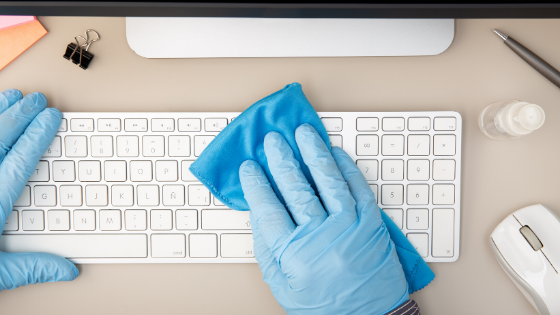 Keeping a workplace clean is essential to keeping it safe. Cleanliness matters under all working conditions. It isn’t just for the public’s benefit, either: A clean workplace helps your team stay healthy and gives them greater pride in the work they do.
Keeping a workplace clean is essential to keeping it safe. Cleanliness matters under all working conditions. It isn’t just for the public’s benefit, either: A clean workplace helps your team stay healthy and gives them greater pride in the work they do.
In the industrial workplace, you’ll often hear project leaders and facility managers talking about disinfecting a work site. Cleaning and disinfecting are related, but they aren’t the same. When you know the difference, it’s easier to hold your workplace to a high-performance standard.
The Difference Between Cleaning and Disinfecting Your Workplace
Just like within the home, cleaning is often performed on a regular basis. You don’t need a special reason, such as a commercial painting project, to clean. Disinfecting, however, is a much more intensive process. It requires special supplies and the right techniques.
As a rule of thumb, you can define the difference this way:
- Cleaning: Removing dirt, germs, and other impurities from a surface
- Disinfecting: Killing germs on surfaces using purpose-made chemicals
Cleaning is essential to keeping a workplace functional. Still, it only moves rather than removes germs. Cleaning alone does have a mild to moderate effect on the spread of germs: It lowers their numbers and makes it less likely people will come in contact with them.
In situations where there’s a risk of infection, something more is warranted.
Disinfecting focuses on disrupting germ colonies by killing germs. Disinfecting, by itself, doesn’t necessarily clean a surface: For example, you could disinfect some surfaces with rubbing alcohol but still fail to disrupt dirt or chemical residue present on the surface.
With that in mind, it’s crucial that these processes go hand-in-hand. Cleaning and disinfecting the workplace is similar to disinfecting your home, but it is critical to follow all steps carefully. Appropriate precautions can help you slow down the spread of infectious diseases in your facility.
The Best Ways to Reduce Germ Spread in Your Workplace
You should both clean and disinfect a workplace on a regular basis. Cleaning should come first, as it removes any surface impurities that might already be conducive to the growth of bacterial colonies. After germ numbers have been reduced, disinfecting is more effective.
Cleaning and disinfecting should be performed at the same time. Precise methods for doing so vary based on the surface or material you are working with. In general, though, most of your effort will go toward a few common porous and non-porous materials.
Shared electronic devices make up a third category of concern for many offices. Luckily, these smaller items are much easier to keep tidy as long as everyone on the team does their part.
Here’s how to handle common cleaning and disinfecting issues:
1. Cleaning and Disinfecting Non-Porous Materials
Wear disposable gloves when preparing to clean or disinfect hard surfaces like chairs, handles, walls, doorknobs, and other surfaces. Gloves should be used only for a single cleaning and then disposed of. Wash your hands immediately after removing the gloves.
Most non-porous surfaces can be cleaned effectively using detergent or soap and water. A variety of disinfectants can then be applied. Some industrial workplaces require specific types of disinfectant, but a bleach solution is effective for the majority of businesses and homes.
Diluted household bleach at a concentration of at least 1000 parts per million of sodium hypochlorite can be used on most hard surfaces. Before using any disinfectant, ensure that it is not past its use-by date and that adequate ventilation will be available until it has dried.
2. Cleaning and Disinfecting Porous Materials
Porous surfaces like carpets and rugs can be more challenging to fully disinfect. Some businesses will opt to have this done professionally – for example, carpets can be steam cleaned. If this work is done in-house, ensure that appropriate cleaning products are used for each surface. Never mix household bleach with ammonia or any other cleaning agent, as this can be hazardous.
3. Cleaning and Disinfecting Your Electronics and Other Office Supplies
Cell phones, tablets, touch screens, and remote controls are just a few items that can easily transfer germs from one person to another. Many commercial and industrial workplaces now rely on a “Bring Your Own Device” model, but some equipment will inevitably be shared.
Note that all electronic and office devices come with manufacturer’s instructions for cleaning. To enhance cleaning and disinfection, consider using plastic sheaths or covers for all devices: These easily wipe off and can be fully disinfected in just a few seconds. Alcohol-based wipes or sprays are most effective for disinfecting touch screens; these should contain at least 70% alcohol.
Cleanliness is a concern on many people’s minds. Make it a regular part of your workplace and you’ll not only have a better looking workspace, but one more conducive to your overall health.
{{cta(‘fd4914b0-3c1e-4f1c-8f59-26ff1c87e1af’)}}






